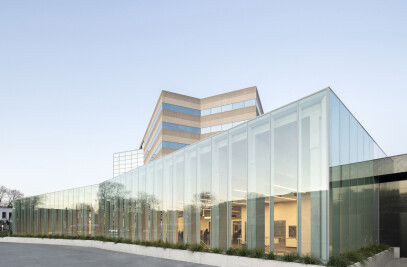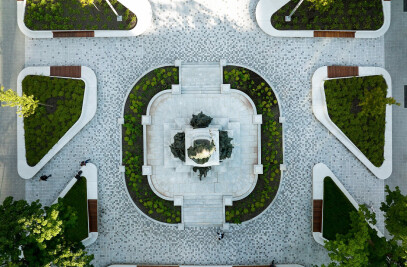With construction of the new Claire and Marc Bourgie Pavilion of Quebec and Canadian Art at the Montreal Museum of Fine Arts, the architects at Provencher Roy + Associés Architectes have achieved a remarkable conversion of a heritage church. At a time when conservation of the religious patrimony is a challenge all over the world, this architectural intervention is an exemplary model of the genre. Its excellence has been acknowledged by the 2010 Canadian Architect Awards of Merit, the Grand Prix du design 2011, and the Prix d’excellence 2011 from the Institut de développement urbain du Québec, which, upon presentation of its award, congratulated Provencher Roy + Associés Architectes for “its thorough architectural reflection with regard to this project, its exceptional urban integration, and its design, which brings past and future together.” In 2012, the pavilion received the Award for Architectural Integration of Montreal Architectural Heritage Campains.
Beside the restored former Erskine and American Church, transformed into a 444-seat concert hall, the rear annex has been completely reconstructed in contemporary style to form the new art pavilion. “The project was complex because it entailed designing a building capable of featuring the Quebec and Canadian art collections while establishing a dialogue with the church, with the museum’s other pavilions, and with the city,” explained Claude Provencher, founding partner of Provencher Roy + Associés Architectes.
Restoration of the Erskine and American Church Built in the late nineteenth century in the massive neo-Roman style of the Trinity Church in Boston, the Erskine and American Church is an important patrimonial landmark, not only for its architecture but also for its history and its contribution to Montreal’s urban landscape. Evidence of the rise to power of the city’s Scottish Protestant élite and an era when the “Golden Square Mile” was home to 70% of Canadian wealth, this building, made of limestone with insertions of Miramichi sandstone, has an original textured façade and a Byzantine-style dome testifying to the city’s architectural richness. In addition, the 20 Tiffany stained-glass windows gracing the lateral façades form the largest collection of its type in Canada.
Respecting the recommendations made by Jean-Claude Marsan (member of the Historic Sites and Monuments Board of Canada and director of the conservation of the built environment program at the School of Architecture of the Université de Montréal), the architects of Provencher Roy + Associés Architectes meticulously restored the church’s envelope. Some parts that were too badly damaged were completely resculpted. The 146 stained-glass windows (including the 20 Tiffany windows) were removed, restored, and reinstalled behind glass panels that make the building watertight. Inside, the plaster ceiling and the mouldings were completely restored, as were the woodwork pieces adorning the nave.
Architectural dialogues With its restraint and permeability, the new Claire and Marc Bourgie Pavilion of Quebec and Canadian Art establishes a natural dialogue with the city. From every level, the glazed openings offer a view of the city and, at the building’s foot, the museum’s sculpture garden, a linear exhibition of works of public art bordering the museum. In addition, the glassed-in atrium at the top of the pavilion offers a strong visual link with Mount Royal, an emblematic element of Montreal’s identity.
Another dialogue is established with the church. The new pavilion shares more than its entrance and reception areas with the former religious building. It also evokes its spirit both by its elevation, extended by an opening to the sky, and by the presence of subtly designed alcoves around the galleries.
To complete the integration of pavilion with its surroundings, the architects linked it to the museum’s other pavilions, both physically and metaphorically. First, the basement entrance is connected to the museum’s underground network through a corridor underneath Sherbrooke Street and connects to the Jean-Noël Desmarais Pavilion. This 45-metre passageway becomes a space for introduction to the new pavilion as it contains monumental works by Quebec artists, such as Riopelle’s Ice Canoe. Aside from this physical link, the Bourgie Pavilion is symbolically integrated with the museum complex through a reinterpretation of the white marble used for the façades of the 1912 Michal and Renata Hornstein Pavilion and the 1991 Jean-Noël Desmarais Pavilion. The architects clad the new pavilion with a wall of marble from the same Vermont quarry as that of its two predecessors, reproducing the image of the material in its original state, with the design of veins running along the façade. “We wanted to give the feeling that the galleries had been sculpted from a gigantic four-storey-high block of marble,” recalls Matthieu Geoffrion, project manager for the Bourgie Pavilion.
Architecture at the service of the arts As Claude Provencher notes, “A successful museum is a space that invites visitors to a sensory experience that can transport them to an unexplored universe.” The architects therefore decided to create a crescendo of experiences from the basement to the fourth floor of the new pavilion. To start this experiential ascent, the designers excavated under the church’s floor to create an entrance for the pavilion and service areas (ticket office, coatroom, restrooms, and so on). Behind, five levels offer a chronological scenario, from the colonial era and the galleries for nineteenth-century art to the period of the Refus global and its heritage, as well as Inuit art. As visitors travel through time and rise physically in the building, the natural light becomes more intense, reaching a climax with the panoramic glassed-in atrium on the top floor.
The central stairway, providing a link between the chiaroscuro of the basement and illumination at the top of the building, allows for this crescendo of light (despite the moderated lighting that is required in most of the galleries for conservation of the artworks) with progressively larger and larger visual openings to the exterior. On the third level, a bay window gives onto an outdoor terrace that features the new work by Dominique Blain. Aside from its emphasis on light, the glassed-in atrium on the top floor has a figurative value. Its shape, evoking an ice structure inspired by an igloo, establishes a symbolic link with the Inuit works that are on display below.
Record attendance OR Number of visitors rises Attesting to the loyalty of a constantly expanding public, the number of visitors to the “reinvented museum” has reached historically unprecedented peaks, with growth of 36% in one year. This spectacular rise makes the museum the most visited in Quebec and the second-most visited in Canada, after Toronto’s Royal Ontario Museum.

































